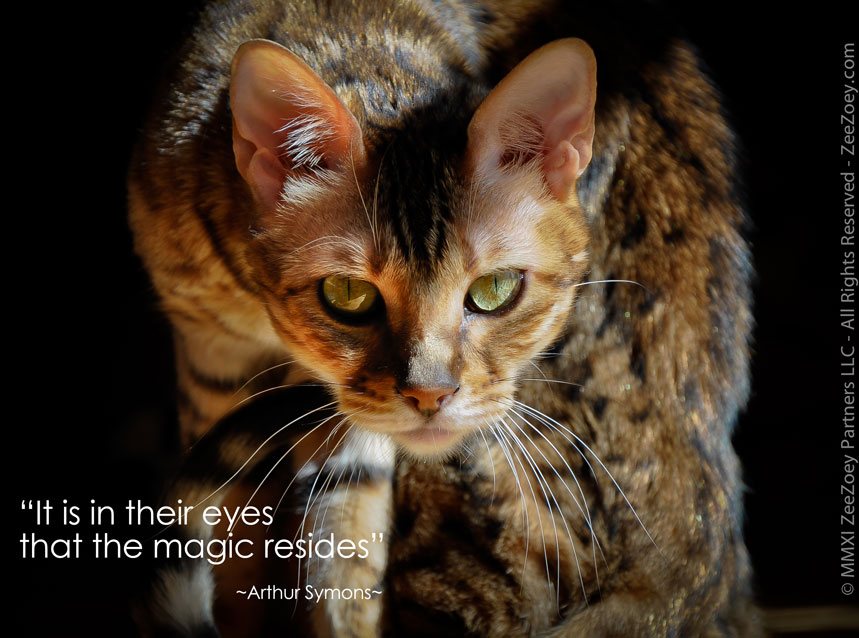
With technology allowing us to capture moments in time as they happen, writers have come to rely more and more on using photos to complement their storytelling. This is especially true for those of us that write about cats – many of us have blogs or websites that demand a visual presence alongside the written word and with books being published online as well, the need for good photos is even more important. But how to take a stunning photo? Not all writers are gifted photographers and while cats make a glorious subject, taking a good picture of them can be easier said than done. It’s nearly impossible to tell a cat what to do, which typically results in a blurry picture of a cat with demonic red eyes if you don’t know what you’re doing with your camera and your cat.
I happen to be very blessed – the man I am engaged to is a brilliant photographer and he has a particularly sensitive eye when it comes to taking pictures of our cats. As a result, I have a fantastic gallery of photos to choose from when I blog and I have even taken a handful of good photos of my cats myself, learning from his tried and true photography techniques. But, not everyone at the Cat Writers’ Association has a live-in photographer like I do and since I know we all love beautiful cat photos, he has graciously agreed to share his Top Ten Tips for taking purr-fect cat photos with all of us!
1. Develop Rapport
Your cat, unlike humans, does not understand what you are trying to do and won’t just pose for pictures. After a bit of petting and some mild play-time, your cat will be more relaxed and ready for his cameo.
2. Be Patient
Photographing felines requires a lot of patience. If you’re rushed, your cat will detect your anxiety. After a while, the novelty of the camera will wear off and your cat will be more relaxed and reveal his true self.
3. Getting Down to Their Level
Keeping your cat comfortable and at ease is very important, so rather than forcing him to come to you, go to him. Get down to his level and shoot from the floor or at your cat’s eye level or just below.
4. Use Natural Light
If indoors, avoid shooting with flash as the burst of light will not only cause red-eye, but may also frighten your cat.Always try to use natural light when taking your cat’s photograph as the light is more natural and flattering. Light coming in through a window can produce a soft and pleasing appearance.
5. The Golden Hour
If you are taking photographs of your cat outside, the ideal time is in the first or last hour of sunlight, otherwise the light may be too harsh. Hollywood film makers call this the ‘Golden Hour’ as the light is more horizontal in direction and golden in color. Overcast days will produce nice even lighting with very subtle shadows.
6. Capture Character
A successful image is one that conveys the character of its subject, so if you have a playful cat photograph him in action, or if you have a lazy cat, photograph him relaxing on a window sill but be sure to capture him with his eyes open. Remember, your cat is a beautiful and graceful animal and you want to capture images of your cat being a cat.
7. Keep the Eyes Sharp
Be sure to focus on your cat’s eyes and keep them sharp. As they say, the eyes are the windows to the soul, so having ‘tac-sharp’ eyes (in focus and razor sharp) is important.
8. The Element of Surprise
It is very difficult to get your cat to hold still and look into the camera. Allow your cat to settle into its environment while you compose your shot. Then when you are ready, either whistle or use a squeaky toy held near the lens to get them to look in the direction of the lens. This will provide you with a few seconds to capture him in an alert posture.
9. Get in Close and Use Simple Backgrounds
Get in close and fill as much of the frame as possible with your cat. Also, by keeping your background simple and uncluttered, attention will naturally be drawn directly to your pet and produce a pleasing image.
10. Take Lots of Images, Study & Practice
In today’s digital age, there are not costs for film, so do what professionals photographers do – take lots of images. Most pro’s get two great images for every hundred or so that they shoot, so practice and experiment. Study cat photos that you like, look at the lighting and the positioning of the cat, and then try to replicate what the photographer has done.
Photo credit – Thank you to my fiance, Dan Power, for not only sharing his great photography tips, but for providing me with the stunning image of my cat, Zoey, for the post header.
Thanx so much for the wonderful tips on photographing cats.
Never fails! They always move!
I am a professional photographer as well as cat writer (and other types of writing). Though my main focus of photography is horses and landscapes, I do love to capture pictures of my cats and the kitties at the shelters I volunteer for… I just want to say I LOVE the photo in the header (Zoey)… I would love to know what your EXIF information is for this photo?